Simon Crawford is a painter based in Knaresborough. He studied History of Art and English at Nottingham University before going on to the Byam Shaw School of Art in London to complete a Diploma in Fine Art. He has exhibited extensively across the UK with his work being included in The Royal Academy Summer Exhibitions, the Jerwood Drawing Prize, Dean Clough Gallery in Halifax, The Mercer Gallery in Harrogate, a touring exhibition to Moscow and other Russian cities. More recently his work has been exhibited at the Ryedale Museum and art gallery, Silson contemporary Harrogate, McGee gallery, York, House of Nidd, Pineapple Gallery, Bishop Auckland, and Ripon Cathedral open show.
His work often depicts abstracted and actual human forms and landscapes with bold, energetic marks using incredibly varied and distinct colour palettes for each series. Court Spencer went to his studio to find out more about his practice and what he’s working on.

‘Dusk Brims’, ‘Yellow Fields’ and ‘Cool of the Night’ by Simon Crawford.
Court: Hi Simon. So nice to meet you and thanks for having me over. This place is brilliant, you can tell I’ve stepped into the home of an artist! It’s fab to see all your work up and this is the first painting I saw of yours (‘Wassailing’ below) at Silson Contemporary in Harrogate a few years ago. It’s like some sort of raunchy Guernica – I love it!
Simon: Well, that’s a neat description – it’s difficult not to be aware of Picasso’s drawing legacy and be influenced by it. This painting is part of a larger series of works. I tend to work in series – either I mix up a set of colours I’m going to use and when they run out that’s the end of the series. Or it is an idea that runs as a series: Cathedrals, India, Dorset or Cornwall, local landscapes, people, or variations on each theme. Art can be made from any subject matter.
Court: You’ve mentioned Picasso. Are there any other influences you’re aware of in your work?
Simon: I’ve been influenced by an eclectic bunch of artists: Roy Oxlade, Roger Hilton, Gillian Ayres, Spencer, John Hoyland, Samuel Palmer, De Kooning, Fred Williams, Dennis Creffield, Turner, Constable, Guston. They keep popping back to see me and I scavenge from their work. Apart from these artists it is the landscape, and mood of a place, a remembered feeling or glimpse of a figure that insinuate themselves into my work through the line, form and colour. It can seem random, but I don’t think it is really. There is an instinctive grasping for colour or a line borne from many experiments and failures.
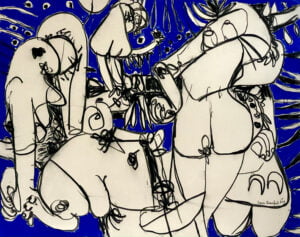
‘Wassailing’ by Simon Crawford.
Court: Has it always been painting for you? Did you dabble with any other media when you were studying?
Simon: I did a lot of life drawing at art school – something every student should do. It teaches you to really look at everything. I enjoyed printmaking, especially etching and dry point printing. It’s a great medium, making images with such lovely velvety black ink. But ultimately, I like making unique images even if they are in a series, rather than repeat things. Although prints are a good way of making money. I never got on with sculpture – it seemed very slow and very technical!
Court: You’re an artist and up until about five years ago you were also the Head of Art at King James’s School here in Knaresborough. Did you know from a young age that art was going to play such a significant part in your life? Did you grow up in quite a creative environment?
Simon: I loved teaching but always made art as I was doing this – it helped understand what students were trying to do too. I remember a Turner exhibition I went to in 1975 that had a huge impact on me. Such a radical artist for his age – uncompromising really. Samuel Palmer was also a hero – I recall going to the Ashmolean to see his drawings which were so fragile you had to sit with white gloves on to handle them. Gorgeous jewels of things. I knew that I understood a visual language more than any other form of communication – I felt at home within this language. I can remember very feeble things I did as a young boy very clearly. My parents encouraged me to paint – it wasn’t as if it was something you couldn’t or shouldn’t do. I had nothing else that I was really interested in, except cricket. Art has always been a big part of my upbringing and life from a very early age.
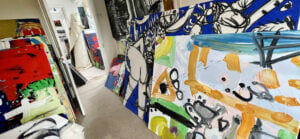
Paintings in the storeroom.
Court: Your work has such a sense of energy about it and you’re quite prolific – you could fill a decent sized gallery several times over! Do you work quite quickly?
Simon: I work fast. I think this comes from working as a teacher at the same time – there wasn’t much time or energy left over at the end of the day, so the stuff had to go on quickly! I’ve never been one to labour my work – when I do it usually gets worse and worse. I like the gestures that the quick physical act of painting or drawing make – you work up a sweat getting across the canvas. Sometimes it’s very hit and miss, but there is an instinct from years of practice.
A painting sometimes might seem to take a day. But actually it’s really taken 40 odd years to be able to get to that point; to distill everything down in a shorthand of marks and gestures.
And it’s really important to try and keep reinventing oneself creatively otherwise you get very stale and self-satisfied. Also, it’s very boring working on exactly the same stuff year in year out and I am quite restless in this sense. You have to shake yourself up every so often. The ideas probably don’t change that much but the way of imparting them must. It’s exciting never being quite sure what’s going to turn up on the canvas. If you know exactly what you are going to do, as Bacon said, why bother doing it?
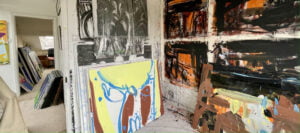
Studio looking through to storeroom.
Court: That’s a good point that it’s not so much about the time it takes but the years of experience that allows you to paint in this way. I really like how confident your lines are and that they form a record of the moves you’ve made throughout the painting or drawing. Do you approach drawing and painting in a similar way?
Simon: It’s a very physical act, which is why I love working on a big scale. Although it is necessary to go really small sometimes as it allows you to work even quicker to get ideas out and resolve issues. And you run out of enough materials to do big work.
I approach drawing and painting in the same way, I’m always searching for a shape or line. In paint you have the added problem of all that colour. I do love black and white, there’s something about the absence of colour that allows your imagination to go a bit further and it’s even quicker of course. Sometimes I will slow right down and do some more detailed drawing, I feel the need occasionally to get more precise about things. But I’ve never been afraid of just putting charcoal or paint to the paper or canvas – it gives me a kick – I actually feel excited and nervous just before getting going and this is like a drug almost. I need that adrenaline rush.
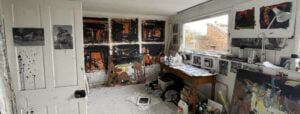
Studio space.
Court: It feels like you’ve got a great set up here with storage in the cellar, and the studio and storage space on the top floor. Have you always had a studio space at home?
Simon: Not always in the house, I used to have a fabulous studio in Cable Street, London, overlooking the Thames. We were on the top floor and watched Canary Wharf going up day by day. Then when we moved to Norfolk I built a studio at the end of our meadow. Nowadays I just have to climb up to the top floor of the house. This has its advantages as I can just go and take a peek late at night after working on things. And, as Guston said, it’s nice knowing that there are figures and images alive up there all the time waiting for me to return and carry on making them.
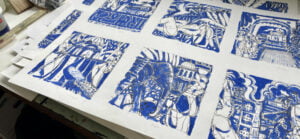
‘100 images of India’ by Simon Crawford.
Court: Do you sketch or paint in locations or do you take photos and use those as source materials to work from in the studio?
Simon: Both really. Little sketches as I’m impatient – but enough to get the gist of an idea. I use photography as an aide memoire – but rarely actually use them. I can remember places and figures well. It’s more to do with what Hodgkin talks about – the memory of feelings about a place or a person.
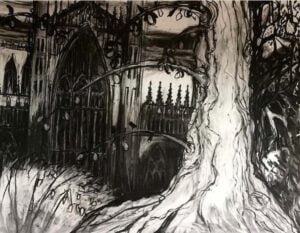
‘York Minster’, part of his Cathedral series by Simon Crawford.
Court: Speaking of places, can you please tell us a little about your series of cathedral drawings?
Simon: There is an artist called Dennis Creffield who was commissioned to do a series of drawings of English cathedrals. They are among some of the best drawings in English Art. I wanted to make things using this idea, so I did. I did make drawings from the cathedrals but was relying on memory and photos a lot. I never got close to Creffield’s way of interpreting the stone into gorgeous marks and compositions. Mine are too romantic I think.
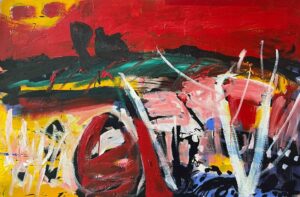
‘Whinny Bank Rievaulx’ by Simon Crawford.
Court: You’ve been in some great exhibitions not just in the UK but internationally. What do you consider to be some of your career highlights to date?
Simon: I’m not really sure. Having any exhibition is a highlight and I’m pretty grateful to all those gallerists who show some confidence in my work. The best is yet to come. I hope.
Court: Do you have a dream project that you would like to make happen?
Simon: I think I’d really like to be paid a vast amount of money as a commission, to follow in the footsteps of Creffield, and take a campervan to all the English cathedrals and draw them from 4am on a summer’s morning. It would be a huge and exceptionally challenging job. Either that or be offered a show at MOMA, New York.
Court: I don’t think it should be one or the other, perhaps you could show your commissioned cathedral drawings at MOMA! People can follow you via Instagram. Do you have any upcoming exhibitions we can keep an eye out for?
Simon: A couple of things in the pipeline that are at a very early stage of getting set up. But I had a little show of work in a tiny gallery called House of Nidd recently. It was a pop-up show but the essence of it was that it was very un-arty, if that makes sense. There are a lot of people who are intimidated by art and going into galleries – the whole art experience turns them off yet they like art. This was a way of trying to ditch the arty side. And I liked it. And I sold stuff. There should be more of these sort of events – the big galleries can show anything and get away with it. I’d like to make my work as accessible as possible.
Court: I totally agree! Art can be intimidating but it really doesn’t need to be. I think it’s important to strip all that away and make it friendly, welcoming, and accessible. I’ve been talking about curating exhibitions in my home for years now…maybe 2022 is the year to finally do it!
Thank you so much for letting me snoop through your studio. It’s been an absolute joy and I very much look forward to seeing your work again in an upcoming exhibition in whatever form that may take.
Filed under: Art & Photography
Tagged with: art, artist, column, drawing, exhibitions, figurative, interview, landscapes, painter, painting, Simon Crawford, vibrant
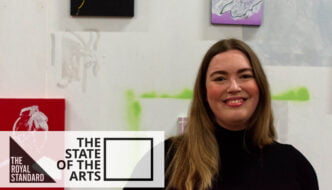
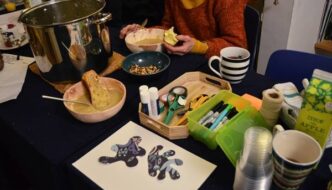
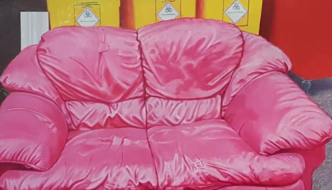
Comments